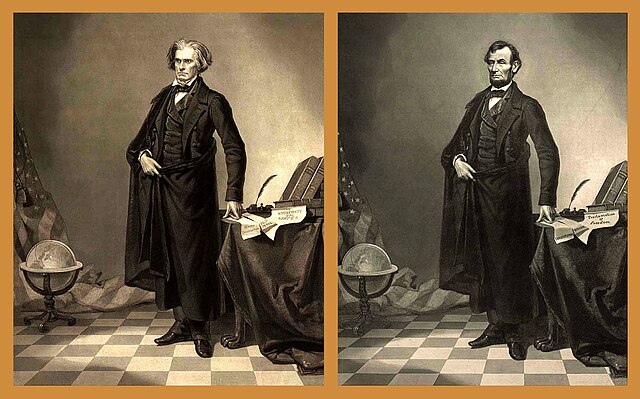Photograph manipulation involves the transformation or alteration of a photograph. Some photograph manipulations are considered to be skillful artwork, while others are considered to be unethical practices, especially when used to deceive. Photographs may be manipulated for political propaganda, to improve the appearance of a subject, for entertainment, or as humor.
Australian photographer Frank Hurley formed this composite photograph from three original negatives of World War I Belgium. Hurley argued with superiors over the ethics of compositing photos, arguing that war was conducted on such a vast scale that it was impossible to capture the essence of it in a single negative.
Lincoln's head superimposed on a print of John C. Calhoun was not discovered for almost a century, when photojournalist Stefan Lorant noticed Lincoln's mole was on the wrong side of his face.
General Grant at City Point is a composite of three different photographs.
Goebbels family portrait photo in which the visage of the uniformed Harald, who was actually away on military duties, was inserted[citation needed] and retouched
Image editing encompasses the processes of altering images, whether they are digital photographs, traditional photo-chemical photographs, or illustrations. Traditional analog image editing is known as photo retouching, using tools such as an airbrush to modify photographs or editing illustrations with any traditional art medium. Graphic software programs, which can be broadly grouped into vector graphics editors, raster graphics editors, and 3D modelers, are the primary tools with which a user may manipulate, enhance, and transform images. Many image editing programs are also used to render or create computer art from scratch. The term "image editing" usually refers only to the editing of 2D images, not 3D ones.
A colorized version of originally black and white photo, colorized using GIMP
Original black and white photo: Migrant Mother, showing Florence Owens Thompson, taken by Dorothea Lange in 1936.
This is a photo that has been edited as a Bokeh effect, using a Gaussian blur.
Leonardo da Vinci's Vitruvian Man overlaid with Goethe's Color Wheel using a screen layer in Adobe Photoshop. Screen layers can be helpful in graphic design and in creating multiple exposures in photography.




![Goebbels family portrait photo in which the visage of the uniformed Harald, who was actually away on military duties, was inserted[citation needed] an](https://upload.wikimedia.org/wikipedia/commons/thumb/c/cc/Bundesarchiv_Bild_146-1978-086-03%2C_Joseph_Goebbels_mit_Familie.jpg/640px-Bundesarchiv_Bild_146-1978-086-03%2C_Joseph_Goebbels_mit_Familie.jpg)



